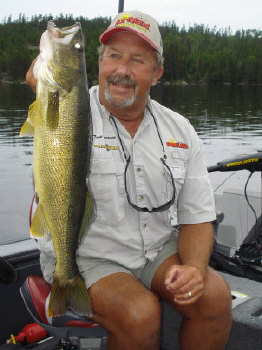Twists to a Timeless Approach for Spring Walleyes
Category: article
Jan 29th, 2009 by OutdoorsFIRST
Modified Jan 29th, 2009 at 12:00 AM
Some states have an official “Walleye Opener”. It’s circled on calendars in kitchen after kitchen. In equally as many states, though, “Opener” describes the second that the ice vanishes. Either way, I believe the ties to the tradition of the “Opener” are too strong.
 |
|
|
Photo Courtesy Of Northland Tackle
|
Let me explain in an anecdote… Three generations of the Doe family get together on that hallowed weekend and cross their collective fingers that the walleyes will bite. No matter the weather. No matter what experts say about the lake. No matter nothing. They fish the same lake every year.
Not that the relatives shouldn’t get together and fish. But unless your lake oozes with spring walleyes, you’re better off leaving the comfort of the cabin, putting the boat on the trailer and driving to a bite.
That’s not meant to be harsh. It’s factual. And here are some tips for picking the right pond and putting a bend in your rod.
Flat as a Pancake and Colored like Syrup
Our education as fisherman tells us that walleyes are fish of clear water and deep structure. That’s only partially true. Yes, walleyes thrive in crisp clean northern lakes. But likewise, they can flourish in bowl-shaped lakes with more weeds than rocks and water colored like beef-bullion. In fact, they often grow faster and are more plentiful in the soupier stuff.
The point is that if your family cabin rests on a cold clear lake, consider nearby options.
The flatter and shallower the area the faster the water warms – fact. Nothing speeds up post-spawn recovery like daytime heat. Walleyes get in gear faster, especially the males. They’ll form six, eight, and ten member packs and work the flat. Simultaneously, the warming shallows load up with baitfish. The combination is lethal.
Big Pieces of the Same Thing
A long expansive flat looks totally boring on a map. “No structure, no fish,” one might say. My guiding buddy Brian “Bro” Brosdahl sees things differently. “I look for the least contours on a lake map,” says the Frabill fishing pro. “Having structure nearby is a bonus, but not a prerequisite.”
Bro really likes large flats on the warmer, north end of the lake, where cold spring winds are fought back and the sun strikes the longest. Build in some walleye spawning structure and the campers will be even happier.
“Can’t beat the pea gravel to golf ball sized rocks. Perfect spawning habitat. And a great place to rest and feed after breeding,” says Bro.
Scattered rock is welcome as well. Essentially, you’re looking for fat shoreline flats with hard and irregular bottoms; gravel here, sand there, rocks in between. Even though fish are working mostly flat surfaces, instinct still guides them towards available structure and edges.
Certain shoreline points also fall into this category. Not the sharp tipped point with cascading sides; maybe later this summer, but not now. You want a point that’s more of a swollen section of the bottom. Compare your thumb to a kids’ pinky finger. You want the point to look like your thumb, flatter and wider.
Bro further qualifies the perfect point. “My favorites will open into the main lake from a bay. Again, bigger, longer and flatter points are best. It’s typical for the attached bay to contain darker, warmer, and shallower water. The bay’s water conditions mix with the main lake, creating improved conditions for spring walleyes.”
Super stealthy spot: There’s a phenomenon that occurs on large sandy lakes. Wave after wave crashing against a shoreline can dig out a little trench. The back-churning water actually relocates the sand. The change in depth doesn’t need to be dramatic, either. I’ve found walleyes in a six foot deep trough with four foot edges.
The Soft Sell
Remember these fish are just coming off the spawn. Their attitudes are down in the dumps; probably not moving around much, either. (Note that their moods can flip like a light switch. Suddenly they’ll go nuts, usually following a string of warm weather days.)
Generally speaking, early spring walleyes won’t climb over each other to grab a lure. And force feeding isn’t an option. As a result, I throw an old-standby – the jig and minnow – but deliver it in a slow and seductive manner.
Go as light as possible. Depending on wind and depth, that means nothing over 1/8th ounce. 1/16th ouncers are preferred. And even though it’s called a jig, don’t jig it. You drag it. Think about how you Texas-rig for bass. Pulls and tiny lifts, no jerking.
The Fire-Ball Jig from Northland Tackle is ideal for dragging. Its short-shank makes quick business of short strikes. The minnow’s lips sit right against the base of the jig head. Doesn’t take much for a walleye to find the hook.
You can pitch it or drift it. With a little wind I like drifting, stopping and starting with the Minn-Kota, keeping it slow and steady. In flat calm conditions, troll around and fan-cast, but still retrieve slowly. Anchoring and dragging is an option, too, especially if it’s really rough or fish are concentrated in an area.
The motion of the drag puts a light load on your rod tip. Feels like you snagged a bread bag. The smooch of a sluggish walleye simply increases that load. Give it some time, up to even ten seconds – walleyes have no trouble carrying a light jig. If the line twitches or the fish makes a turn, set.
I’m not trying to ruin your family tradition. But I would like to see you catch more fish. Check some maps. Ask around. Remember, your cabin doesn’t have feelings.